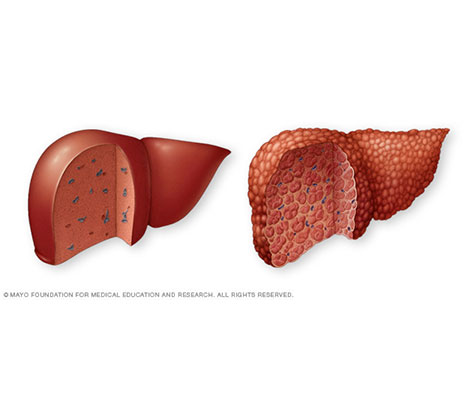Cirrhosis:
Cirrhosis refers to the replacement of normal liver tissue with non-living scar tissue. It is always related to other liver diseases.
Why is the liver important?
The liver is the second largest organ in your body and is located under your rib cage on the right side. It weighs about three pounds and is shaped like a football that is flat on one side.
The liver performs many jobs in your body. It processes what you eat and drink into energy and nutrients your body can use. The liver also removes harmful substances from your blood.
What is cirrhosis?
Cirrhosis is the scarring of the liver - hard scar tissue replaces soft healthy tissue.
As cirrhosis becomes worse, the liver will have less healthy tissue. If cirrhosis is not treated, the liver will fail and will not be able to work well or at all.
What causes cirrhosis?
Cirrhosis is caused by chronic (long-term) liver diseases that damage liver tissue. It can take many years for liver damage to lead to cirrhosis.
Chronic Alcoholism
Chronic alcoholism is the leading cause of cirrhosis in the United States. Drinking too much alcohol can cause the liver to swell, which over time can lead to cirrhosis. The amount of alcohol that causes cirrhosis is different for each person.
Chronic Viral Hepatitis
Chronic hepatitis C is the second leading cause of cirrhosis in the United States. Hepatitis C causes the liver to swell, which over time can lead to cirrhosis. About one in four people with chronic hepatitis C develop cirrhosis. Chronic hepatitis B and hepatitis D also can cause cirrhosis.
Nonalcoholic steatohepatitis (NASH)
Fat build up in the liver that is not caused by alcohol use, is nonalcoholic steatohepatitis (NASH). NASH can cause the liver to swell and can lead to cirrhosis. People with NASH often have other health issues including diabetes, obesity, high cholesterol, coronary artery disease and poor eating habits.
Bile Duct Disease
Bile duct disease limits or stops bile from flowing to the small intestine. The bile backs up in the liver causing the liver to swell and can lead to cirrhosis. Two common bile duct diseases are primary sclerosing cholangitis and primary biliary cirrhosis.
Genetic diseases
Some genetic diseases can lead to cirrhosis. These diseases include Wilson disease, hemochromatosis, glycogen storage diseases, Alpha-1 antitrypsin deficiency, and autoimmune hepatitis.
What are symptoms and complications of cirrhosis?
There are usually no symptoms of cirrhosis in its early stage. Over time, cirrhosis may cause symptoms and complications:
Symptoms
Loss of appetite
Tiredness
Nausea
Weight loss
Abdominal pain
Spider-like blood vessels
Severe itching
Complications
Jaundice, a yellow discoloration of the skin and whites of the eyes
Gallstones
Bruising and bleeding easily
Fluid build up and painful swelling of the legs (edema) and abdomen (ascites)
Hepatic Encephalopathy (HE), a buildup of toxins in the brain that causes both mental and physical complications
How is cirrhosis diagnosed?
Cirrhosis is diagnosed by symptoms, blood tests, medical history, and physical examination. A liver biopsy may be needed to check how much of the liver has been damaged. During a biopsy, a small piece of liver tissue is removed and studied in the lab.
How is cirrhosis treated?
Treatment options for cirrhosis depend on the cause and the level of liver damage. Depending on the disease causing cirrhosis, medications or lifestyle changes may be used for treatment. The goals of treatment are to prevent further liver damage and reduce complications.
When cirrhosis cannot be treated, the liver will not be able to work and a liver transplant may be needed. Doctors will determine whether a liver transplant is the best treatment option.
What is the best way to manage cirrhosis?
It is possible to prevent further liver damage with proper management of cirrhosis.
Maintain a healthy lifestyle (eat a healthy diet and exercise regularly)
Limit salt in your diet to prevent or reduce fluid buildup
Avoid raw shellfish
Stop drinking alcohol
Talk to your doctor about all of the medications, vitamins and supplements you take.
Talk to your doctor about hepatitis A and hepatitis B vaccinations
Practice safe sex
Use clean needles for tattoos or piercings
Do not share needles, razors, toothbrushes or other personal items with others
